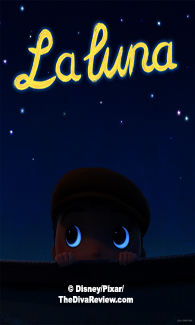
Hey boys and girls, we just had the best luck in having an early look at the newest Pixar offering, a gorgeous seven-minute fairy tale called La Luna. Writer/director Enrico Casarosa chatted with us about his first time helming a Pixar project, Hayao Miyazaki’s influence and the challenges of animated facial hair.
Dig it!
La Luna
Director Enrico Casarosa
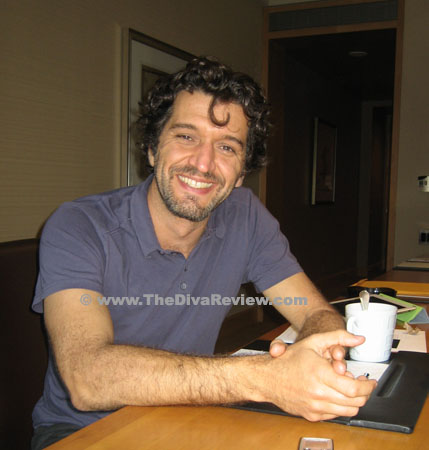 The
Lady Miz Diva: La Luna is such a beautiful, imaginative film. Where
did you find the inspiration for this lovely story?
The
Lady Miz Diva: La Luna is such a beautiful, imaginative film. Where
did you find the inspiration for this lovely story?
Enrico Casarosa: It was a couple of ingredients coming together: The core of it is a personal story; I grew up with my grandfather in the house and he did not get along with my dad. So, I was a little bit of that boy stuck in the middle of these two big personalities. So I was pretty interested in trying to tell that story of a little boy trying to find his own way between these two looming characters. That felt like something I experienced and it was a good core. Then the second part is a little bit of what I love; inspirations {that} come from great literature. I love Italo Calvino; he’s an Italian writer who’s done a lot of great, very fantastic and strange stories. So I felt it would be great to put together this very simple, personal story with something very fantastic. I always loved moon myths; is it made of cheese, what is it made of? So it was fun to come up with my own myth. So, those things came together and it was really fun to try to make something that could be very fable-like, but also very also kind of mundane and simple with simple people, peasants.
LMD: Simple people with a very important job.
EC: So often those are the kind of characters in folk tales. I wanted that kind of flavour.
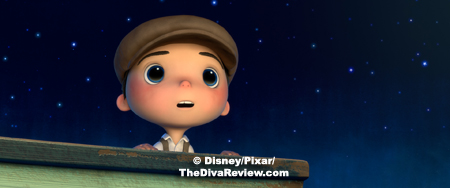 LMD: This is your first directing role on a
Pixar film after years of working in the trenches as a story artist on
films like Cars and Ratatouille. What is it like to make your own
short?
LMD: This is your first directing role on a
Pixar film after years of working in the trenches as a story artist on
films like Cars and Ratatouille. What is it like to make your own
short?
EC: It’s very different. You’re also dealing with features. Feature work is difficult. I think we really rack our brains to try and make the stories better and better. We work hard for years on a feature; screening after screening, just trying to make it better. I had a story that had a good shape; it was a little bit more about sculpting it and learning a huge amount of stuff during it. It felt like a huge privilege and so much fun. I’ve had big jobs, but I always say this specific year, the production of this movie -- it would be Sunday night and I would be like, ‘Yes, it’s Monday tomorrow,’ and I have never said that. Even with the good jobs I’ve had, that was pretty unique because it felt like every day you would see a little piece of this puzzle coming together. I think the fact that this story had a good heart and direction and core made it easy for me to direct it and made it easy for me to get people behind it. So, I think the story does a lot with us. It’s not about the person; it’s more about the life of a story.
LMD: I spoke to Pete Docter and Jonas Rivera about Up and I asked how long it took to make that film, and they said, “Oh, five years,’ like it was nothing.
EC: Yeah, it’s a marathon. This is a sprint compared to that.
LMD: What are the differences in time and the amount of crew that you have making a short?
EC: There are a lot of limitations. The shorts need to be relatively cheap. And there are so many artists in the studio and features are always the trump card over you. You’re always trying to fit in between the big production needs. It’s an interesting puzzle to put together; just the staffing itself. But you have to see those limits as a challenge and we were lucky enough to get really great people at the right moment. Some of them were also good friends; Dice Tsutsumi {Pixar art director}, for example, did a lot of beautiful art for it, and he was helping me even before I was pitching it. Robert Kondo’s production design together with Bill Cone, they’re so talented in animation. Another great artist is Rodrigo Blaas, who directed this wonderful short himself called Alma; he was our animation lead and he was really great to have because he had just gone through directing a short himself. So, I had really good help.
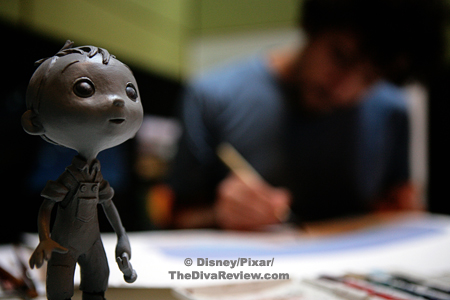 LMD: Out of the hive of Pixar creative artists,
I’m sure many of them also have stories to tell. How did you get yours
made?
LMD: Out of the hive of Pixar creative artists,
I’m sure many of them also have stories to tell. How did you get yours
made?
EC: You know, I feel like we end up never feeling too much like, ‘Ooh, I wanna get it over other people’s.’ What we end up doing is telling each others’ stories a lot. And you want your peers’ thoughts; you want to tell it and say, “What do you think of it?” and someone’s gonna give you some cute little idea and it’ll get better. So, it’s pretty wonderful that way. I feel there’s a lot of little things that made this short so much better and they came from feedback from people around me. In the presentation I give about making it, I always say the first steps are really telling the story and retelling and retelling it. So you’re telling it to a lot of people around you and I think that’s a great way to start shaping it. You can see what people react to, you can see very quickly what people think is interesting and what’s not. At the base of it, that’s the beginning. Then you keep on sculpting it by storyboarding it, then the real details, you flesh it out.
LMD: What was the most challenging aspect to animate?
EC: You know, we had a few challenges with the hair. Grandpa’s and Papa’s hair was not easy. I thought it would be great to have this {Mimes character talking in gibberish with mustache covering mouth} face with hair. In my mind, I thought it would be cheap. It’ll be great, we don’t even have to model mouths. Well, I was wrong because we’ve done a lot of mouths, but we haven’t done moving hair that you control as an animator. It took us a while to get it cos its technology, it’s just hard to give the control to the animator. Normally, hair is simmed on top of animation, so the computer just figures out it’s gonna flow this way. Well, we needed the animator to make it go with the voice, so that was an interesting challenge. I think it was an important thing to do it. It worked in symbiosis with this idea of the gibberish, I thought, also, with this idea of these characters being closed in. They are the opposite with the little kid. They’re not looking any more.
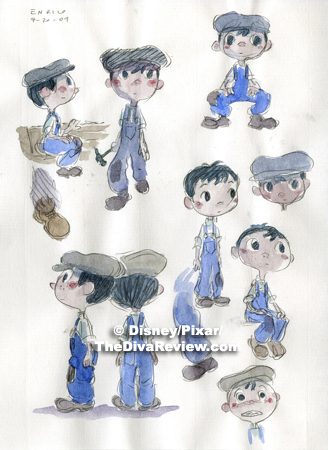 LMD: Now that you mention the challenge of the
facial hair, was that the motivation behind having no dialog?
LMD: Now that you mention the challenge of the
facial hair, was that the motivation behind having no dialog?
EC: No, the gibberish was there to begin with. I always loved cartoons with gibberish; I bring up La Linea, which is an Italian cartoon by {Osvaldo} Cavandoli I watched. It’s a wonderful cartoon. I love how Italian it is, but also completely universal. There’s a gesture or quality to this little guy that’s Italian, but you know from wherever you are, you know what he’s feeling. I thought that would be perfect for this; that they would have the flavour, but also the universality of it.
LMD: The music of La Luna is just lovely.
EC: Yeah, Michael Giacchino, it’s amazing what a job he did. We asked him to reach for his roots. His parents are first generation, so they still speak Italian and he kind of embraced the idea of getting inspired by Nino Rota. I gave him a lot of Fellini soundtracks and some Neapolitan music. I was really looking for something folky Italian for the score. I think he put on such a great balance between such a simple folk guitar and then still get the full orchestra later in the short.
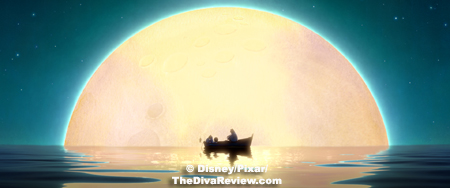 LMD: You mentioned Cavandoli, but who are some
of your other animation influences?
LMD: You mentioned Cavandoli, but who are some
of your other animation influences?
EC: {Hayao} Miyazaki’s a huge influence. There’s a few homages there in the short and just the way I feel visually and the way I draw, the way I think is so influenced by those movies. We’ve all watched them and rewatched them and studied them to the point of being slightly obsessed about them. And at Pixar you’ll find a lot of friends that way; from John Lasseter himself, we all love these movies so much. So I wanted to try and bring some of that feel and see how would some of those visuals work in CG; the wake of the boat, for example, we tried to do a little bit Ghibli-like. It was an interesting challenge.
LMD: Speaking of Japan, you screened La Luna as part of a charity benefit last night for Japanese Earthquake Relief. How did you get involved with that?
EC: Justin Leach organised it. We’ve been good friends for many years. We worked together at Blue Sky Studios. He lived in Japan for many years and I went to visit him many times. We’ve both been in love with the culture and animation -- all around. We have a lot of friends in Japan; we have such a connection there. We’ve done more than the charity; we’ve done some art auctions earlier this year after the disaster. So, when he came up {with the idea for the event} I said, “Hey, I would love to help. Maybe I should see if we can show La Luna.” So, I was very happy to see Pixar’s support at a fundraiser like this. So, that’s why we’re here and it’s been really nice.
LMD: What are you working on next?
EC: I’m working with Bob Peterson who’s doing this untitled Pixar dinosaur movie, which you’ll see in 2013.
~ The Lady Miz Diva
Sept. 12th, 2011
© 2006-2022 The Diva Review.com
|
|
|
|

